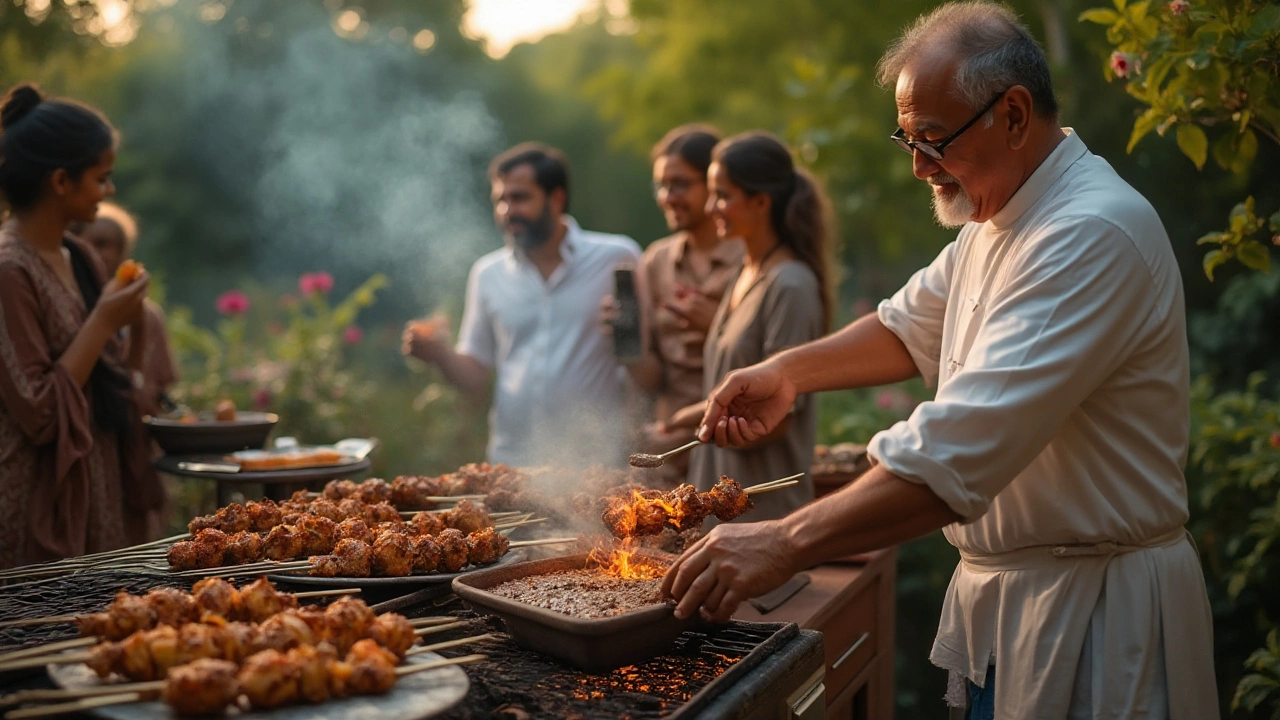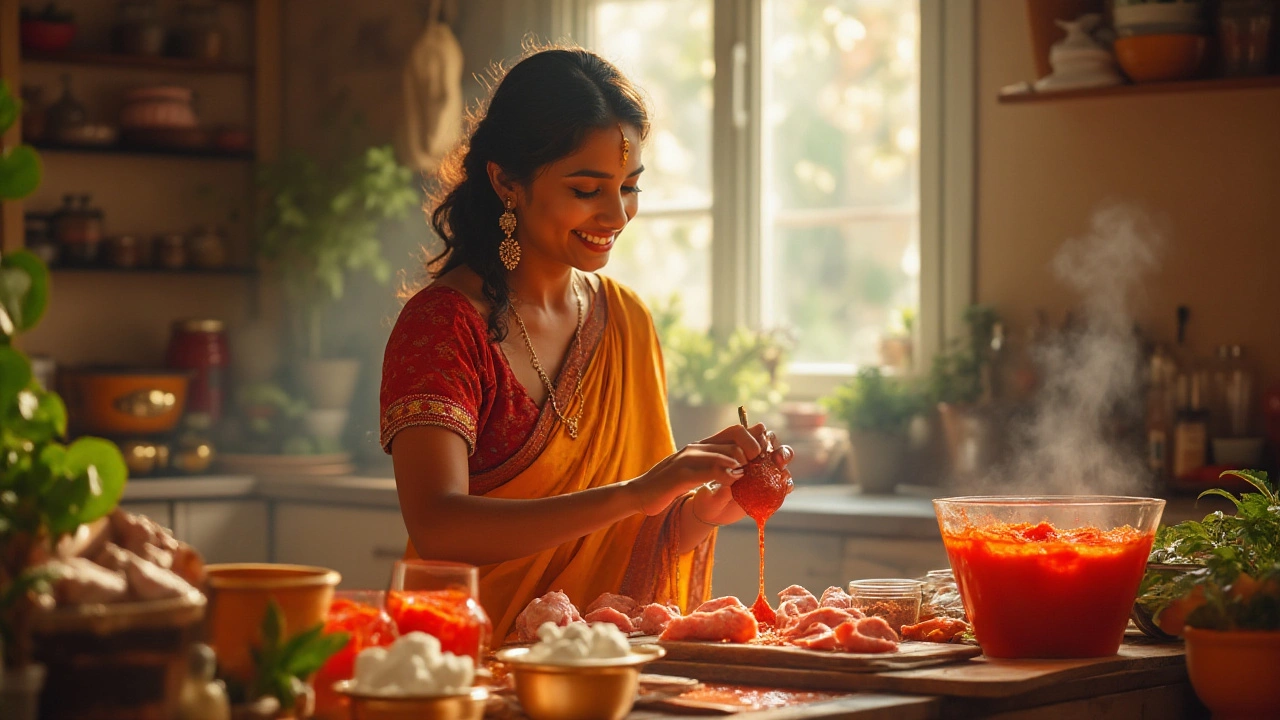Tandoori chicken, with its vibrant hue and tantalizing aroma, is a staple of Indian cuisine loved by many across the globe. The secret to its irresistible flavor lies in its marinade—a perfect blend of spices and yogurt that infuses the chicken with deep, aromatic notes.
Crafting the ideal marinade is both an art and a science, requiring a careful selection of ingredients and precise timing. In this article, you'll learn the essentials of creating a marinade that not only enhances the flavor of the chicken but also tenderizes it to juicy perfection. Whether you're a seasoned chef or a kitchen novice, this guide is designed to help you master the art of making tandoori chicken at home with ease.
Let's dive into the key components and tips that will transform your next tandoori cooking experience into a delightfully authentic venture.
- Ingredients for the Perfect Marinade
- The Role of Yogurt
- Spices to Enhance Flavor
- Marinating Techniques
- Cooking Tandoori Chicken
- Serving Suggestions
Ingredients for the Perfect Marinade
Creating the perfect marinade for tandoori chicken is both an art and a science. It starts with understanding the balance of flavors and how each ingredient plays a role in transforming the mundane into something extraordinary. The marinade essentially forms the foundation for infusing the chicken with that characteristic zest that makes it so beloved in Indian cuisine. The cornerstone of tandoori marinade is yogurt, which acts as both a tenderizer and a flavor enhancer. The lactic acid present in yogurt helps break down the proteins in the chicken, making it succulent and tender. Combining this with a medley of spices like cumin, coriander, and turmeric creates a symphony of flavors that dances on your taste buds.
The Marvelous Spices
Aside from the yogurt, the spices are what define the true nature of tandoori chicken. Garam masala, a staple in Indian kitchens, adds depth with its warm, earthy undertones. Red chili powder brings the heat, while turmeric provides not only its earthy bitterness but also that iconic golden color. Did you know that turmeric has been lauded for its anti-inflammatory properties? According to a study published in the Journal of Medicinal Food, regular consumption of turmeric may contribute to health benefits, though moderation is key. Adding ginger-garlic paste elevates the marinade with a sharp, fragrant kick, balancing the creaminess of yogurt. Watch how these spices blend harmoniously, each enhancing the other while also holding their own ground.
"A perfect tandoori marinade is like a well-conducted orchestra, each ingredient playing in tune but not overpowering the other," says chef Vikas Khanna.
Assembling the Ingredients
Here's a look at how you can put these ingredients together. Mix the yogurt with freshly squeezed lemon juice to add a subtle tang. This citrus twist not only works as a flavor enhancer but also aids in tenderizing the meat further. Prepare a spice blend with cayenne pepper for extra heat if you prefer spicy dishes. You can include freshly chopped cilantro and mint for a refreshing twist, offering a break from the heavy spices. The use of fresh ingredients, like ginger-garlic paste made at home, can elevate the dish tenfold compared to store-bought options, which may contain preservatives. A pinch of salt and pepper to taste, ensuring that every piece of chicken carries a balanced flavor profile.
| Ingredient | Amount |
|---|---|
| Yogurt | 1 cup |
| Ginger-Garlic Paste | 2 tablespoons |
| Lemon Juice | 2 tablespoons |
| Garam Masala | 2 teaspoons |
| Turmeric Powder | 1 teaspoon |
| Red Chili Powder | 1 teaspoon |
Once gathered, simply whisk the ingredients together in a large bowl until smooth. The beauty of the marinade lies in its ability to be customized to suit your taste buds. Want it spicier? A dash more of chili powder. Less intense? Dial it down with a touch of yogurt. The transformative nature of this marinade is what gives tandoori chicken its revered status in the culinary world.
The Role of Yogurt
Yogurt plays an indispensable role in the creation of authentic tandoori chicken. It serves as the cornerstone of the marinade, offering not just flavor but also an essential cooking function. The primary reason yogurt is used in tandoori marinades is its ability to act as a tenderizing agent. The natural lactic acid content in yogurt works gently on the chicken, breaking down proteins without altering them too harshly. This ensures that the meat remains moist and succulent after cooking. Unlike stronger acids like lemon juice or vinegar that can sometimes toughen the meat, yogurt’s mild acidity contributes to a tender texture, making it ideal for gradual marination.
Apart from tenderizing, yogurt is an excellent binder for spices. As it clings to the surface of the chicken, it allows the various spices—like cumin, coriander, and the striking red of paprika—to meld together into a cohesive blend. This is crucial for building the characteristic flavor profile of tandoori chicken. The slight tanginess of yogurt also combines beautifully with these spices, creating a marinade that is both robust and balanced. Moreover, yogurt's cooling properties help balance the heat of the spices, making the dish palatable for those who enjoy milder heat. The use of yogurt marinades is a time-honored tradition in Indian cooking, especially for grilling and roasting meats, giving them a signature texture and taste.
The quality and type of yogurt can also impact the final dish. Full-fat yogurt is often preferred, as the fat content contributes to a richer taste and luscious mouthfeel. In some traditional recipes, the yogurt is sometimes strained, which reduces the water content and increases the marinade's thickness. This results in a more concentrated flavor and a crispier exterior when the chicken is cooked in a tandoor or on a grill. An interesting fact about yogurt in Indian cuisine is how it's utilized as part of a comprehensive approach to flavor and texture enhancement, dating back several centuries. The choice of spices combined with yogurt hasn’t changed significantly, indicating a timeless culinary practice that appeals to modern tastes.
In the culinary community, the use of yogurt in marination is often praised.
"Yogurt is a one-stop solution in Indian marinades, providing tenderization, flavor, and an exciting dance of spices," says Chef Vikram Sunderam, a celebrated chef in contemporary Indian cuisine.This historical ingredient continues to be a vital part of tandoori chicken recipes, treasured for its unique capabilities to transform a simple dish into an extraordinary delight. With its deep-rooted significance in enhancing taste and tenderness, yogurt remains a quintessential component that no aspiring chef should overlook when crafting the perfect tandoori dish.

Spices to Enhance Flavor
Spices are the heart of any authentic tandoori chicken recipe, and they play a pivotal role in building the flavor profile that is both complex and memorable. The beauty of tandoori cuisine lies in its sophisticated use of spices, which marry beautifully with the creamy texture of yogurt and the protein of chicken. When creating the perfect marinade, selecting the right spices is crucial. Commonly used spices include cumin, coriander, garam masala, turmeric, and of course, the vibrant paprika which contributes to the signature reddish hue of tandoori chicken.
Each spice brings its own unique properties to the table. Cumin offers a warm, earthy taste that pairs well with the tanginess of yogurt, while coriander adds a hint of citrusy sweetness. Garam masala, a quintessential Indian spice mix, provides depth with its combination of cinnamon, cloves, cardamom, and black pepper—all roasted and blended together. Turmeric, known for its vibrant yellow color and health benefits, adds a mild, mustard-like note, working harmoniously with the other spices.
Cayenne pepper or red chili powder is often added for those who enjoy a touch of heat. It's important to balance the spice levels to ensure they enhance rather than overpower the natural flavors of the chicken. According to chef and author Madhur Jaffrey, known for her expertise in Indian cuisine, "The magic of Indian cooking is in the balance of spices, each one carefully chosen to work in harmony with the others."
The ratios of these spices can be adjusted according to personal taste. Some might prefer a spicier kick, while others might favor a milder infusion. It's worthwhile experimenting with these quantities to find the perfect balance that suits your palate.
For a more nuanced flavor, some cooks like to add additional ingredients such as ginger and garlic, which contribute a fragrant pungency to the marinade. Fresh herbs like cilantro or mint can also be finely chopped and mixed in, adding freshness and complexity to the overall profile of the dish. Mint especially pairs well with yogurt and can elevate the dish with its cooling effect, which contrasts beautifully with the warmth of the spices.
Marinating Techniques
Marinating is a crucial step when preparing tandoori chicken, as it deeply infuses the meat with flavors that define the dish. This process should not be rushed, as the magic happens when each component of the marinade has time to mingle with the chicken. To start, choose chicken pieces with bones, like drumsticks or thighs, as these cuts absorb flavors better compared to boneless pieces. The skin should be removed to allow the spices and yogurt to penetrate more effectively. Make deep incisions on the meat, assisting the marinade in reaching the innermost parts, which ensures every bite is as flavorful as possible.
The choice of ingredients in your marinade can significantly affect the final taste. Yogurt serves as the base, creating a creamy consistency that clings to the chicken and tenderizes the meat. Adding a squeeze of lemon juice can enhance the tenderizing effect, but be mindful of proportions. Too much acid might cook the chicken, altering the texture. Spices like cumin, coriander, and garam masala are essential, each bringing its unique aroma to the dish. Freshly grated ginger and garlic paste enriches the marinade, offering the characteristic depth associated with the dish. Adjust the seasoning with salt, but remember to account for potential reduction during cooking.
Timing is another key aspect of marinating. For optimal flavor, marinate the chicken for at least 6 hours, or better yet, let it rest overnight in the refrigerator. The longer the marination, the more pronounced the flavors will be, producing a dish that transports your senses straight to an aromatic Indian kitchen. If you're short on time, a minimum of 1 to 2 hours will suffice, though the results might not be as profound. A tightly sealed container or a secured plastic bag will work well for keeping the chicken submerged. Ensure to turn the pieces halfway through the marinating period, promoting even flavor dispersion.
"Marinades not only enhance taste and flavor, but they actually help the protein structure to become more tender," says culinary expert Samin Nosrat in her book 'Salt, Fat, Acid, Heat'.
An optional but beneficial step is to bring the marinated chicken to room temperature before cooking. This duration lets the mixture settle into the meat's core, while also reducing cooking time due to the pre-warmed state, ensuring juicier results. As your kitchen fills with the aromatic smell of spices, you'll appreciate the patience required at this stage. Mastering the marinating technique is not just about learning recipes; it's also about integrating them into your cooking routine, making tandoori chicken a signature dish in your repertoire.

Cooking Tandoori Chicken
Cooking tandoori chicken is more than just following a recipe; it's an immersive experience that bridges traditional techniques with modern kitchens. The true essence of this dish comes alive when you understand the delicate balance of heat and flavor. Traditionally, tandoori chicken is cooked in a tandoor, a cylindrical clay oven heated with charcoal or wood, which imbues the chicken with a distinct smoky flavor. However, most home chefs can achieve remarkable results using conventional ovens or grills.
Start by preheating your oven to its highest setting, typically around 450°F (230°C), to replicate the intense heat of a tandoor. If you're using a grill, aim for a medium-high heat to ensure those lovely char marks. Place a wire rack over a baking sheet lined with foil to catch the drips if you're oven-cooking. This allows the heat to circulate around the chicken, crisping up the outside while keeping the inside juicy and tender.
Place the marinated chicken on the rack or grill, ensuring enough space between each piece for even cooking. Depending on the size of the chicken pieces, cooking time will vary, but boneless pieces generally require 20-25 minutes, while bone-in pieces might take up to 40 minutes. It's important to turn the chicken halfway through cooking, basting it with melted butter or oil to maintain moisture and enhance the sheen. This step not only adds flavor but also helps in developing that characteristic crimson crust.
For those interested in adding extra authenticity, smoking the chicken can elevate its flavor profile. Alton Brown, the famous culinary scientist, often highlights the benefits of techniques like smoking in enhancing dishes with layers of complexity. You can replicate this at home by using a small bowl of hot charcoal. Place it in your grill or oven during the last few minutes of cooking to infuse a deep, smoky aroma into the chicken. It mimics the traditional atmosphere of a tandoor, according to several chefs who swear by this method.
Ensuring that the internal temperature of the chicken reaches at least 165°F (74°C) is vital for safety, so using a meat thermometer is always a wise choice. Once cooked, allow the chicken to rest for a few minutes before serving. This step is crucial for redistributing the juices throughout the meat, resulting in a succulent bite every time. For those interested in presentation, serve garnished with fresh coriander, a squeeze of lime, and a sprinkle of chaat masala to further elevate the dish.
This exploration into cooking tandoori chicken at home brings not only a taste of India but also the joy of mastering a beloved dish. Remember, each step you take is not just about cooking, but connecting to a culinary tradition cherished worldwide.
Serving Suggestions
When it comes to serving tandoori chicken, presentation and pairing can elevate the dining experience. Traditionally, this aromatic dish is complemented by naan, a type of soft, fluffy flatbread that soaks up the spices beautifully and adds a touch of comfort to the meal. If you're venturing into the world of homemade Indian cuisine, freshly made naan or even store-bought options, warmed in the oven, are almost essential partners to this dish.
Adding some freshly cut vegetables and herbs can enhance both the flavor and the visual appeal of your meal. A side salad with cucumber, tomato, and red onions tossed in a tangy vinaigrette provides a refreshing contrast to the smoky notes of the tandoori chicken. If you have the time and inclination, prepare a mint chutney or yogurt-based raita to accompany the chicken. These condiments not only cool down the heat but also highlight the complex flavors of the spices.
The Charm of Sides
While traditional accompaniments are popular for a reason, modern twists can offer delightful surprises. Try pairing your tandoori chicken with roasted vegetables such as eggplant or bell peppers. Their sweetness and charred edges juxtapose the savory elements perfectly. A squeeze of lemon, before serving, can enhance the freshness of the dish, tying all the components together in a delectable harmony.For a unique spin, some culinary enthusiasts recommend serving tandoori chicken as a mainstay in wraps or sandwiches. Spicy chicken, tangy sauces, and fresh veggies wrapped in a pita or whole-wheat tortilla make for a convenient and tasty option that captures the essence of Indian flavors. As popular chef Sanjeev Kapoor once said,
"Creativity with traditional recipes is what brings out the joy in everyday cooking.".”
Pairing with Beverages
Choice of drinks can also significantly influence the dining experience. A glass of chilled mango lassi, with its creamy and sweet notes, complements the spicy tang of tandoori chicken. For adults, a crisp, not-too-sweet white wine or a light lager beer can be ideal options that cut through the richness of the dish, refreshing your palate with each sip.A well-plated tandoori chicken dish is not only about taste but about bringing a small piece of India to your dining table. Whether you're indulging in an elegant dinner party or a casual backyard barbecue, these serving suggestions deepen the allure of this classic dish and invite everyone to savor it in style.
